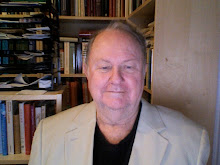Lecture Four presented a plethora of unfamiliar, disparate objects. Their contrasting, even contrary emphases suggest that Late Antique/Early Christian art has no style of its own. This heterogeneity is in fact rooted in Roman art, which developed on different tracks, depending on whether the work was official, funerary, private, or sectarian. The Decius portrait and the Christian building at Dura Europos are almost exact contemporaries, but couldn't be more different. The difference resides in the fact that the one belongs to the first Roman category just noted, the Dura frescoes to the last.
The main part of the lecture reprocessed, as it were, the categories introduced last time in an effort to discern organic links between the (incipient) medieval and the modern.
The term Expressionism appeared about 1910 to designate art trends that emphasized the inner theater of emotions as distinct from our processing of sensations (Impressionism, envisaged at E's polar opposite). The artists of Die Bruecke, formed in Dresden in the early years of the century, lie at the core of the Expressionist endeavor. Schmidt-Rottluff's "Melancholia," a woodcut of 1919, is a characteristic example. Works by Kirchner and Heckel were also seen. Godfathers of the movement were Van Gogh and Edvard Munch.
The intellectual underpinnings of Expressionism may well lie in Friedrich Nietzsche's "The Birth of Tragedy" of 1872. This work posits a fundamental dichotomy between the Apollonian and Dionysian. While Nietzsche sees the two in a state of creative tension in the tragedies of Aeschylus and Sophocles, he believed that the duality applied to all of life. Certainly the Dionysian seems to have application to late Roman life with its bloody cults of Mithras and Cybele, not to mention the executions of the Christian martyrs in the arana and (some would say) Christianity itself, where the central feature is the violent death of its Founder.
"Sphericity" is, it is now evident, a special case of Elementarism, a concept introducted by Theo Van Doesburg about 1925. Ultimately the concept stems from a dialogue of Plato, the Philebus. Here Plato maintains that the most fundamental principle of beauty lies in basic geometric forms. A visit to a humble carpenter's shop will illustrate this point, as the carpenter produces straight lines and circles with the appropriate instruments, resorting to a lathe for 3-D counterparts such as cylinders, cones, and spheres. This concept was illustrated by a page from Le Corbusier's programmatic treatise "Vers une architecture" of 1923. More recent cases of squares and cubes, circles and spheres were discussed. The cross form remains problematic in that, once Christian ideas had been attached to it, they were not readily dismissable.
The ideal of flatness is traceable to Sir Henry Cole's campaign for design reform in England, following the fiasco (as many saw it) of the kitschy, pretentious objects in the first world's fair of 1851. Cole and his allies held that carpets and wall hangings should not attempt to show depth, but much be kept relatively flat. William Morris mass-produced products embodying these principles. Edouard Manet transferred them to the fine arts, as seen in his "Fifer." Other examples were seen in works of Maurice Denis, Klimt, Matisse, and Georgia O'Keeffe.
The concept of tonal unification is easily referenced to impressionist, neoimpressionist, and postimpressionist work.
A number of examples the use of geometrical matrices were presented, including work by Adolf Gottlieb and Judy Chicago.
The aesthetic of the sketch came to the fore (as Albert Boime has shown) in the middle of the 19th century. A good exposition of this idea appears in Hawthorne's Roman novel, "The Marble Faun." A sketch by Delacroix for his monumental "Death of Sardanapalus" documented the freshness and freedom of such exercises, qualities that tend to be lost in the finishe work.
Proportional flexibity appeared in work by Picasso and Miro'.
Paul Signac seemed to have adopted (or adapted) his style by reference to the faceting of the mosaics in Ravenna and Constantinople.
Perhaps the most important of the categories was the idea of stylistic heterogeneity, the cohabitation of two or more styles in a single work. This was shown in two works by Picasso, his "Demoiselles d'Avignon" and an analytic Cubist still life. To the best of my knowledge, this feature (found of course in the Mary icon from Mt. Sinai) has not been adequately theoretized in art, though Bakhtin's polyphonic concept addresses it in literature. In Saul Steinberg's classic New Yorker cover each of the six figures has his or her own style, wittily making clear the link between (artistic) style and lifestyle.
Perspectival manipulation famously occurs in late Cezanne. De Chirico and Klee show more radical efforts. Ultimately these departures may be connected with non-Euclidean or Riemannian geometry, which emerged in Central Europe in the middle of the 19th century. In this mathematical concept, Euclidean geometry, the basis of "scientific perspective," is but a special case of the larger field of non-Euclideanism.
Seriation was referred to 19th century architecture, where (as in the Crystal Palace) a small number of basic, identical building components were utilized. Warhol's Marilyn Monroe diptych is a striking example in painting.
Overall patterning appears in the work of many abstract artists, as in Agnes Martin and (more contoversially) Jackson Pollack.
Late-antique architecture carried the Roman mallebility principle (assured by the use of concrete) to new heights. Erich Mendelsohn's Einstein Tower in Potsdam (1920s) is a landmark example, rejecting as it does the geometrical grids that were de rigueur in the International Style. The TWA Building (Saarinen) and the Bilbao Museum (Gehry) were also shown.
In conclusion it was suggested the the thread connecting all these categories is their willingness to defy the norms of the classicist aesthetic first set forth in fifth-century Greece. Clumsily perhaps, Wilhelm Worringer sought to portray this epochal change as the overcoming of the empathy principle he detected at the foundations of the classical aesthetic.
Wednesday, October 3, 2007
Subscribe to:
Post Comments (Atom)

No comments:
Post a Comment